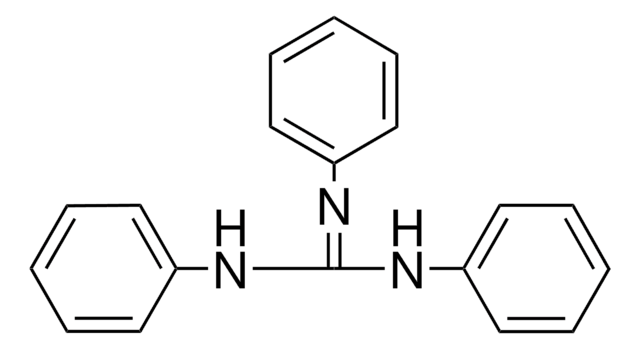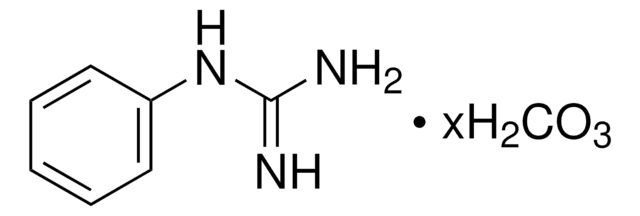1,3-Di-o-tolylguanidine is known to be a selective ligand for the sigma site in the mammalian central nervous system. Behavioral changes, such as hypothermia, reduced pain behavior, circling behavior, and decreased locomotor activity in mice and/or rats were observed after intraperitoneal, subcutaneous, intravenous and/or intranigral injection.
207713
1,3-Di-o-tolylguanidine
99%
Sinonimo/i:
DTG
About This Item
Prodotti consigliati
Saggio
99%
Stato
solid
Punto di fusione
176-178 °C (lit.)
Solubilità
water: soluble 70 mg/mL at 20 °C
Gruppo funzionale
amine
Stringa SMILE
Cc1ccccc1NC(=N)Nc2ccccc2C
InChI
1S/C15H17N3/c1-11-7-3-5-9-13(11)17-15(16)18-14-10-6-4-8-12(14)2/h3-10H,1-2H3,(H3,16,17,18)
OPNUROKCUBTKLF-UHFFFAOYSA-N
Informazioni sul gene
human ... EBP(10682)
Cerchi prodotti simili? Visita Guida al confronto tra prodotti
Categorie correlate
Avvertenze
Warning
Indicazioni di pericolo
Classi di pericolo
Acute Tox. 4 Oral
Codice della classe di stoccaggio
11 - Combustible Solids
Classe di pericolosità dell'acqua (WGK)
WGK 3
Punto d’infiammabilità (°F)
Not applicable
Punto d’infiammabilità (°C)
Not applicable
Dispositivi di protezione individuale
dust mask type N95 (US), Eyeshields, Faceshields, Gloves
Scegli una delle versioni più recenti:
Possiedi già questo prodotto?
I documenti relativi ai prodotti acquistati recentemente sono disponibili nell’Archivio dei documenti.
-
What is the nature of the biological activity of Product 207713, 1,3-di-o-tolylguanidine?
1 answer-
Helpful?
-
-
What is the solubility of Product 207713, 1,3-di-o-tolylguanidine?
1 answer-
1,3-Di-o-tolylguanidine is soluble in water at 70 micrograms per mL at ambient temperature.
Helpful?
-
-
What is the Department of Transportation shipping information for this product?
1 answer-
Transportation information can be found in Section 14 of the product's (M)SDS.To access the shipping information for this material, use the link on the product detail page for the product.
Helpful?
-
Active Filters
Il team dei nostri ricercatori vanta grande esperienza in tutte le aree della ricerca quali Life Science, scienza dei materiali, sintesi chimica, cromatografia, discipline analitiche, ecc..
Contatta l'Assistenza Tecnica.








